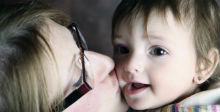Internal mini form
Contact Us Today
For children with Cerebral Palsy, impaired vision can be another roadblock that interferes with developmental growth. Today, there are many ways that members of a child’s medical team can treat vision concerns early, or find alternatives that remove the barriers.
Visual impairment is common in children with Cerebral Palsy
Being able to see and understand images has a major impact on how people function in the world. For children with Cerebral Palsy – many of whom already experience impaired mobility and communication – not having precise visual acuity may contribute to further developmental delay. Not being able to see exacerbates existing difficulties.
Unfortunately, impaired vision is common in children with Cerebral Palsy. There is a higher likelihood that a child will have trouble seeing if they have severe Cerebral Palsy. To further complicate matters, impaired vision can contribute to a diminished life span if the right kinds of interventions and supports are not implemented early in a child’s life.
According to numerous studies, as many as 75 percent of children with Cerebral Palsy experience problems with vision acuity. Because eyesight is a critical element in terms of a child’s emotional and cognitive development, the sooner the children are diagnosed and treated, the better the outcome will be. For that reason, a parent needs to be aware of a child’s ability to see, and find solutions that can restore, or compensate for, the gift of sight.
What is visual acuity, and why is it necessary?
Visual acuity is the acuteness, or the clearness, or a person’s vision. The condition is commonly referred to as nearsightedness or farsightedness.
Perfect visual acuity is dependent on the retina’s ability to focus on an object; the information it perceives is relayed to the brain so a person can understand what he or she is seeing, decipher what it means, and act accordingly. If the retina is not receiving accurate amounts of focused light in the macular region, it affects visual acuity.
When an object or words cannot be easily ascertained because of blurred vision, the information cannot be properly relayed to the brain. Because so much of cognitive development and mobility is tied to the body’s interpretive visual processing system, a child’s ability to understand what he or she is seeing is affected. And, relating to situations is impaired.
The visual cortex is a part of the cerebral cortex – which is responsible for processing visual information. Unencumbered visual input is necessary for the brain to accurately interpret what is seen. This is especially true in infants whose brains are still developing and toddlers who are expected to achieve developmental growth phases.
Much of a child’s success at home and in school depends on visual processing; studies have shown that children with visual impairments struggle with learning setbacks. Behavioral issues – frustration, anxiety, loss of confidence, lowered self-esteem – can surface if the child is falling behind, or believes he or she can’t grasp the information and assignments that peers are able to accomplish.
Some of the complications that impaired vision can cause include:
- Accidents from the inability to properly navigate his or her surroundings
- An impaired ability to learn
- An inability to learn how to read and write
- An inability to understand surroundings
- Behavior problems
There is evidence that impaired visual function is linked to diminished life span in children with Cerebral Palsy. Current studies are focused on determining whether the actual visual impairment is responsible for shortened life expectancy, or whether visual impairment is indicative of a separate brain injury that may be life threatening in itself. Some believe visual impairment may accompany severe cases of Cerebral Palsy, which combined might indicate a risk to life expectancy.
What are some of the visual impairments that a child may struggle with?
Visual impairments are strikingly common among children with Cerebral Palsy. Common visual conditions that are found in children with Cerebral Palsy include strabismus, cataracts and refractive issues. Strabismus is a severely turned eye that makes it impossible for both eyes to work together. Cataracts are cloudy areas in an otherwise healthy lens. Refractive issues involve circumstances where the eyes become blurry or are unable to focus.
Vision acuity concerns can include myopia (nearsightedness), hyperopia (farsightedness), presbyopia (a condition of the lens that can blur vision); astigmatism (an inability see objects that are very close or far away); and refractive errors (insufficient or misplaced light in the retina). This is the most common set of vision issues, and the ones most likely to be corrected by wearing eyeglasses or contact lenses.
In addition, a child with Cerebral Palsy may experience one or more of the following vision concerns:
- Field loss – A person’s visual field is what they can see when they look ahead. If a person cannot see 180 degrees in either direction, he or she may have field loss. Different types of field loss include hemianopia (loss to the right or left, or upper or lower field); central loss (a spot in the center of one’s field of view); and peripheral loss (sight loss at the edges of the vision field).
- Oculomotor concerns – These are conditions that affect the movement of the eye, as well as depth perception. Types of oculomotor conditions include esotropia (eye turns inward); exotopia (eye turns outward); hypertropia (eye turns upward); hypotropia (eye turns downward); strabismus (eye misalignment); and amblyopia (a lazy eye).
- Cortical Visual Impairment – CVI occurs when the eye cannot make sense of what a child sees. This is a condition that exists in the brain, not in the eyes. Sometimes called cortical blindness, many children can see but can’t interpret images. It’s caused by head injuries, strokes, and congenital defects in the brain. CVI can make it very difficult for children to sort out what they see, and relate those objects to what’s happening around them.
What are some indicators that a child may be having visual troubles?
It is not always obvious when a young child has a vision impairment as they learn early on to adapt to their environment.
Children may not realize their eyesight is any different from any other child’s because they don’t know any differently. A child may think that his or her vision is supposed to be blurry if that’s all he or she has been accustomed to. Or, children – especially those that are not yet completely verbal – may not be able to express their concerns. Without a vision exam, it is possible that a child’s vision problems may go undiagnosed for a significant period of time.
There are some physical cues that children will use – whether or not they are verbal – that are a strong indicator that a child may have a visual impairment. Some may be easily corrected by providing the child with a pair of eyeglasses, or a correction may call for more complex intervention.
Some physical signs of visual impairment include:
- Complaints of frequent headaches
- Covering an eye while reading
- Disorganized writing display
- Holding reading materials or picture books very close
- Moving his or her head – versus the eyes – back and forth to read
- Poor hand-eye coordination
- Squinting while focusing on objects
- Turning his or her head to use one eye
- Using a finger to keep his or her place
- Underdeveloped speech and vocabulary
- Written words placed outside of writing lines
What remedies are available to correct vision impairment?
In many cases, eyeglasses or corrective lenses bring about needed improvement for children with visual impairments. In other cases, more aggressive interventions are required.
Children with Cerebral Palsy can benefit immensely if vision can be corrected when a child is young, so he or she can realize the benefits sooner as opposed to later.
In some cases, low-tech modalities produce significant results. If a child is experiencing amblyopia, which is reduced vision for non-pathological factors, such as strabismus, blurring the good eye can force the bad eye to work harder to develop. Patching the good eye is another acceptable alternative. Both of these methods build connections in the brain, especially important while the brain is still developing.
If a child’s visual skills have not evolved to meet milestones laid out by an ophthalmologist even in the event they have eyeglasses or corrective lenses, it may be time to consider more aggressive approaches. Refractive surgeries, such as photorefractive keratectomy, or PRK, and Laser-Assisted in situ Keratomileusis, or LASIK, have evolved and improved.
PRK is a procedure that uses a laser to reshape the cornea by removing a piece of the corneal stroma. LASIK is a procedure in which the cornea stoma is reshaped using a laser.
Although we think of cataracts as an issue for older people, they are actually a common occurrence for children with disabilities. Cataract removal occurs when an eye surgeon removes the natural lens of an eye and replaces it with an intraocular lens.
All surgeries carry risks such as infection, a poor outcome, or a reaction to anesthetic, but PRK, LASIK and cataract removals are generally considered safe. As with most surgeries, a parent should ask the ophthalmologist about proper timing of such procedures, their risks of the procedure, the long-term effectiveness, and any acceptable alternatives.
Sometimes, there is little that can be done to improve a child’s vision. If that is the case, the best course of action to take is to introduce non-visual forms of communication to a child.
Today, there are more books and reading materials available in Braille than ever before; the same form of communication can be used for written communication. Also, technology has brought text-to-speech software that can greatly enhance a child’s ability to learn about the world, and connect with others.
Where does a parent go to have their child’s vision assessed?
If a parent believes a child may have a visual impairment, the parent should consult with an ophthalmologist.
Depending on the nature of a parent’s options through his or her medical insurance, or where he or she lives, they may choose to set an appointment with a pediatric ophthalmologist that specializes in childhood visual disorders. However, a conventional ophthalmologist is trained to recognize, assess, and treat visual issues in children.
In some cases, a parent might be able to receive the services he or she needs from an optometrist, but an optometrist is not a medical doctor, and the nature of the treatment he or she can provide will be limited.
Ophthalmologists are board-certified physicians that are trained in diseases and conditions of the eye. They practice in a variety of locations and work in concert with a child’s medical team.
Places where a parent may seek an assessment from an ophthalmologist include:
- Hospitals
- Specialized clinics
- Residential facilities and nursing homes
- Therapy centers
- Doctor’s office
What are the requirements ophthalmologists must satisfy to practice?
An ophthalmologist must satisfy an aggressive educational requirement to practice this complex medical discipline. Ophthalmologists have the same kind of credentials as other medical professionals since optimizing eyesight requires sufficient training.
In the United States, practicing ophthalmologists are required to earn a bachelor’s degree and attend medical school. A four-year residency that includes internships in surgery, internal medicine, and pediatrics is also required. Candidates may also participate in rotations accredited by the Accreditation Council for Graduate Medical Education or the American Osteopathic Association.
Once these steps are complete, candidates need to sit for a certification exam administered by the American Board of Ophthalmology. Ophthalmologists must complete 300 continuing education credits to re-certify every 10 years.
Most states also require ophthalmologists to acquire a license to practice; they must first be licensed within their own state as a medical doctor or a doctor of osteopathy. In order to be licensed, they must complete medical school and pass all steps of the USMLE, a national licensing exam.
What happens during an eye exam?
The first and most well-known test that will occur in a vision exam is the reading of the Snellen chart. This is the chart that begins with big letters, and ends with very small ones. Once a child reads the chart, it gives the doctor an idea of what symbols, or optotypes, a child can see, and at which angle a child can discern the information. The lowest row a child can read on the chart will determine his or her visual acuity.
When a child is nonverbal, or is an infant, a Snellen chart may not be effective. In cases where a child is too young to answer questions, or unable to answer, the ophthalmologist will deploy other tactics to ascertain visual impairment.
The American Ophthalmologists Association recommends that a child receive an eye exam at six months old. During this exam, the ophthalmologist will take a baby’s medical history, and ask several questions that could provide a better idea of how a child’s vision is developing and changing.
During the exam, a physician will look for:
- Cataracts, congenital or otherwise
- Obstructions in the eye
- How a baby’s eyes work in concert
- How a baby reacts to visual stimuli
- Infections
Another strategy that might be used involves Teller acuity cards, which present pages with a specific number of verbal and horizontal bars on them. The child is assessed to determine whether he or she can discern the bars getting closer together, or farther apart.
A popular test called Visual Evoked Potentials, or VEP, uses a series of electronic images of black and white stripes. As the patterns are presented, they become finer. As this occurs, brain waves are recorded, which provide the ophthalmologist with an idea of what’s awry with a child’s vision.
No matter what the nature of a child’s vision is, a physician will likely perform the following tests to learn more about a child’s condition:
- Distance vision test – A reading of the Snellen chart to determine a child’s visual acuity
- Refraction test – The use of lenses to determine what prescription a child will need for contact lenses or eyeglasses
- Color-blindness test – A child will examine cards with dotted patterns to see if he or she can see different colors
- Eye movement exam – A test that determines whether a child can follow a small light normally
- Slit-lamp exam – A lamp is used to assess the overall health of the eye and its surrounding tissues
- Eye pressure test – A measurement of eye pressure that can indicate if a person is at risk for glaucoma.
- Dilation exam – A test in which an ophthalmologist or a technician will use eye drops to dilate the pupils so the inside of the eye can be examined.
During an eye exam, an ophthalmologist seeks to find the appropriate prescription that will bring a child as close to 20/20 vision as possible. Sometimes, however, a physician will recommend surgery, or another intervention, to enhance a child’s visual acuity.

Associative conditions
Cerebral Palsy affects muscle tone, gross and fine motor functions, balance, coordination, and posture. These conditions are mainly orthopedic in nature and are considered primary conditions of Cerebral Palsy. There are associative conditions, like seizures and intellectual impairment that are common in individuals with Cerebral Palsy. And, there are co-mitigating factors that co-exist with Cerebral Palsy, but are unrelated to it. Understanding conditions commonly associated with Cerebral Palsy will enhance your ability to manage your child’s unique health concerns.
Associative Conditions
Common associative conditions
Click on a condition listed below to learn more.








